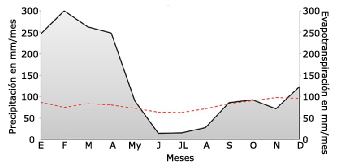
Figure 1. Monthly distribution of precipitation in relation to the potential evapotranspiration model (red line). The fallow area represents the dry months at the Pichilingue weather station.
ORIGINAL
Seasons and planting densities interaction on forage production of eight hybrids maize, Ecuador
Interacción época/densidad de siembra sobre la producción de ocho híbridos de maíz forrajeros, Ecuador
Álvaro Cañadas L,1* Ph.D, Carlos Molina H,1 M.Sc, Diana Rade L,2 M.Sc, Francisco Fernández M,3 M.Sc.
1Instituto Nacional de Investigaciones Nacionales, Estación Experimental Tropical Pichilingue, Km 5 vía Quevedo - El Empalme, cantón Mocache, Provincia Los Ríos, Ecuador,
2Escuela Superior Politécnica Agropecuaria de Manabí. Docente Investigador del Centro de Investigación de las Carreras de la ESPAM-MFL (CICEM). Campus Politécnico Calceta, Sitio El Limón, Calceta, Ecuador.
3Escuela Superior Politécnica Agropecuaria de Manabí del Centro de Investigación de las Carreras de la ESPAM-MFL (CICEM). Campus Politécnico Calceta, Sitio El Limón, Calceta, Ecuador.
*Correspondencia: alvarogustavo.canadaslopez@alumni.uni-goettingen.de
Received: February 2015; Accepted: June 2015.
Objective. To assess the interaction effect of the season and planting densities on the production of eight INIAP corn hybrids. Materials and methods. A research process was conducted in 2013. It was applied a split - split plot design with three replication and Tukey test was used. It was evaluated two planting seasons (28 January and 8 April), they were placed in large plots. Two planting densities (65.500 y 125.000 plants/ha), that were located in the subplots and eight INIAP corn hybrids arranged in the sub- subplots. The evaluated variables were Fresh Matter, Dry Matter, Plant Height and Crude Protein Results. Fresh Matter and Crude Protein productions were influenced by planting seasons. Plant densities affected the production of Fresh Matter, Dry Matter and Plant Height, as well as the interaction season by corn INIAP hybrids. While INIAP corn hybrids showed statistical differences in the production of Fresh, Dry Matter, Plant Height and Crude Protein. The eight INIAP hybrids productions were: Fresh Matter (58.86 ton/ha ±5.19); Dry Matter (21.45 ton/ha ±4.71); Plant Height (2.46 m ±0.16) and Crude Protein (10.6±1.12). Conclusions. The performance showed by hybrids INIAP CML-172, INIAP 6021 and INIAP 551 were very acceptable forage material and could be used for silage purposes.
Key words: Biological production, forage, plant source protein, silage (Source: CAB).
RESUMEN
Objetivo. Evaluar el efecto de la interacción época y densidad de siembra en ocho híbridos de maíz para producción de forraje sobre la obtención de materia fresca MF, seca MS, altura de planta AP y proteína cruda PC. Materiales y métodos. Se empleó un diseño de parcela dos veces dividida con tres repeticiones. Se evaluó el efecto de dos épocas de siembra (28 de enero y el 8 de abril) que se dispusieron en la parcelas grandes, dos densidades de siembra (65.500 y 125.000 plantas/ha) que se ubicaron en las subparcelas y ocho híbridos de maíz INIAP dispuestas en las sub-subparcelas. Las variables evaluadas fueron producción de MF, MS, AP y PC. Resultados. La época de siembra tuvo su influencia sobre la producción de MF y contenido de PC. La densidad de cultivo y época de siembra afectó la producción de MF, MS y AP por híbridos de maíz. Mientras que los híbridos INIAP de maíz mostraron diferencias estadísticas (p<0.001) en la producción de MF, MS, AP y PC. La producción de los ocho híbridos INIAP fue de MF (58.86 Ton/ha ±5.19); MS (21.45 Ton/ha ±4.71); AP (2.46 m±0.16) y PC (10.6±1.12). Conclusiones. Los rendimientos mostrados por los híbridos INIAP CML 172, INIAP 6021 e INIAP 551 son materiales aceptables con relación a las variables evaluadas y pueden ser empleados especialmente para ensilaje.
Palabras clave: Ensilaje, forraje, producción biológica, proteína de fuente vegetal (Fuente: CAB).
According to Cornejo and Wilkie (1) in the latest National Agricultural Census, Ecuador has an approximate bovine population of 4.5 million, dispersed throughout the nation; 51% in the inter-Andean region, 37% along the coast and 12% in the Amazon for milk and beef production. This cattle population is on a land extension of 3.35 million hectares of cultivated grassland and 1.12 million hectares of natural grassland (1). Of the total amount, 55% are criollo breed, 43% are Holstein F, Brahman and Cebuina hybrids and others; a small amount corresponds to pure breeds for meat, milk and double purposes. The total number of production units, about 427.000 are in one way or another used for this purpose (1).
Most of the livestock along the Ecuadorian coast is in areas where lack of rain in the summer results in pasture drying up, thus resulting in a deficit in the supply of cattle feed that results in economic and productive loss, including: absent or diminished heat, weight loss, reduced growth of young animals, birth of weak calves and higher rates of illness and death (2).
Corn silage is widely used for lactating dairy cows that require energy-dense feed to maximize milk production. Decreased water availability is a critical element for agricultural sustainability, particularly in semi-arid regions of the world where there is not a sufficient supply of rainfall. To achieve adequate yields it is necessary to complement this water deficit by irrigation (3). The decline of water resources is exacerbated by an increasing demand for quality fodder necessary to obtain milk. To produce high energy corn silage, an adequate supply of water is necessary at the stage of grain filling. Thus, dependence on the production of dry matter in contrast with its availability is an important factor in maize production (4).
Many components – environmental, cultural and genetic – quantitatively and qualitatively affect the production of fodder maize. Corn planting density can be increased in order to provide maximum production of dry matter (5). Since grain moisture is not of great interest in silage, maize hybrids with higher leaf area and plant height may be employed. Planting density for silage has been essential for both grain production and fodder (6). It has been determined that optimal seeding density depends on the properties of the hybrid (7). Yilmaz et al (6) reported that fodder and dry matter production were significantly influenced by patterns of planting and seeding corn hybrids.
There is a lack of precise information about the time and density planting for eight corn hybrids to produce high yields of fodder. Many experiments have been conducted to determine optimum planting density and sowing times for products developed by the National Institute of Agricultural Research (INIAP) for corn production. However, nothing is known about the behavior of these materials developed by INIAP for fodder production in relation to seasons and planting densities. Thus, the present study aims to evaluate how the time of planting and density affects eight corn hybrids in relation to production of fresh matter (MF), dry matter (MS), plant height (AP), and crude protein (PC) to obtain the greatest amounts of fodder maize in the INIAP Pichilingue Tropical Experimental Station, Ecuador.
MATERIALS AND METHODS
Experimental area. This study took place at the Pichilingue Experimental Tropical Station (EETP) located in the West of the Andes Mountains at 75 m above sea level. The representative climatic season in the research area is Pichilingue, at 79°21‘W and 1°06‘S, with an average annual temperature of 25.47°C, relative humidity at 85.84%, with a heliophany of 898.66 hours light/year, a uni-modal type precipitation with a total of 2.000 mm/year and its distribution is show in in Figure 1.

Figure 1. Monthly distribution of precipitation in
relation to the potential evapotranspiration model (red line). The fallow area represents the dry months at the Pichilingue weather station.
Cañadas et al (8) developed a model that predicts the value of evapotranspiration for 2013, which is described below and was applied to determine the hydric balance in the study area:
PET=20.57*Es*(1-HR/100)
Where:
PET = Evapotranspiration (mm/month)
Es = Saturated steam pressure (m bar)
HR = Relative humidity
The values of monthly evapotranspiration (dotted line) are represented opposite average annual rainfall (Figure 1). These two parameters determined the hydric balance of the Pichilingue station so that the months that showed a deficit in water availability were June, July, August, October and November (Figure 1, benefited area). The province of Los Ríos is within a Tropical RainForest (9).
Data collection. Soil preparation for the experiment consisted of: fallow land, tracking, leveling, and preparation of furrows. In the last tilling, triple super phosphate was broadcast (0-46-0) and potassium murate (0-0-60). Fifteen days later, nitrogen was incorporated (corresponding to 150 kg of urea/ha) and at thirty days nitrogen was again applied (corresponding to 150 kg of urea/ha). This was done at the beginning of the rainy season, on January 28, 2013 and April 8, 2013 at the end of the rainy season (Figure 1). The spacing was 20 cm between each plant and 80 cm between rows (65,500 plants/ha) and 20 cm between plants and 40 between rows (125,000 plants/ha), using genetic material developed by INIAP: 1) (6016) L-41-2-6-1-PICHILINGUE-7928- X L- 237-2-1-3-POBLACION-A1XCML-172; 2) (6017) L-37-7-3-4-POZA RICA-8024 X L- 237-2-1-3-POBLACION-A1 X CML-172; 3) (6020) L-41-2-6-1-PICHILINGUE-7928- X CML-171 X CML-172; 4) (6021) L- 41-2-6-1-PICHILINGUE-7928- X L-37-7-3-4-2-POZA RICA-8024 X CML-172; 5) L-41-2-6-1-10≠PICHILINGUE-7928- X L 237-7-3-4-2-POB-A1 (INIAP H 553); 6) L-237-2-1-3-6POBLACION-A1-X–(CML-172); 7) INIAP-H-551; 8) INIAP H-601.
Statistical analysis. A twice divided plot design was used, two rainy periods were established in large plots and in the subplots two seeding densities were established and in the plots were available sub-sub-plots eight maize hybrids were established with three replications. Each treatment was established on plots of 100 m2 and a total area of 3,600 m2. Analysis of variance was performed using the SAS program (10), and to test for differences between treatment averages the Tukey test was used at five percent.
Fodder production was determined in tons per hectare, harvesting it in from two central rows from the net plot without sampling the last meter at the ends of each row. A digital scale was used with a 40 kilograms capacity. A 1 kg sample of fresh fodder from each plot was taken, placed in paper bags, and sent to the Quality and Nutrition Laboratory of the Santa Catalina Experimental Station to be oven dried at 70 ° C for 48 h. The samples were weighed and put in the oven for an additional 12 h to obtain a constant weight and were then weighed to establish the production of dry matter. At the end of the study, ten plants in the net plot were measured at random to determine plant height. The crude protein content was obtained according to the method proposed by AOAC (11).
RESULTS
Production of fresh material. In table 1, the analysis of variance is presented for fresh material.
Table 1. Significance of half squares for Fresh Material, Dry Material, Plant Height and Crude Protein for eight INIAP hybrids in two seasons and two planting densities at the Pichilingue Tropical Experimental Station.
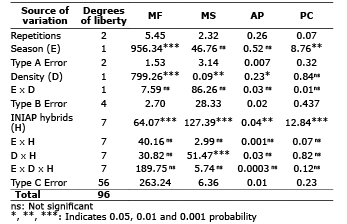
A high statistical significance (p<0.001) for density and planting seasons and INIAP maize hybrids were found. The variation coefficients for large plots 2.10%, sub plots 2.81% and sub-sub-plots 2.13% support the results obtained for this parameter. Using the Tukey measurement test at five percent, the first range of statistical significance was determined (Figure 2A) during the planting season on January 28 2013 and planting density at 125,000 plants/ha (Figure 2B).
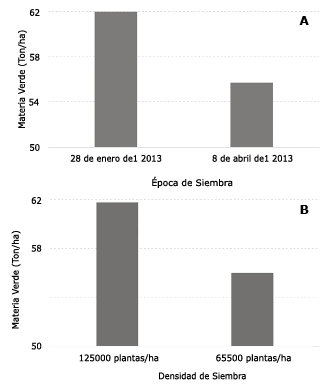
Figure 2. A. MF production (Ton/ha) for two planting seasons, EETP. B. MF Production (Ton/ha) for two planting densities, EETP.
A high statistical difference (p<0.001) was detected for INIAP hybrids (Table 2) where the means for MF was presented, and they were placed in three significant mean ranges. The INIAP 551, INIAP H 601, INIAP H 553 hybrids were in the first range and INIAP CML-172 in the second.
Table 2. Statistical significance of half squares for Fresh Material, Dry Material, Plant Height and Crude Protein for eight INIAP hybrids in two seasons and two planting densities at the Pichilingue Tropical Experimental Station.
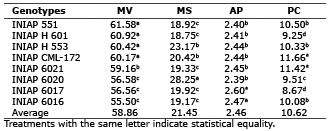
Production of dry material. A high statistical significance (p<0.01) was detected for planting densities where the population of 125.000 plants/ha was placed in the first range with 21.02 Ton/ha and in the second one the density was found (65.500 plants/ha) with a production of 20.95 Ton/ha according to the Tukey test (Table 1). A high statistical discrepancy (p<0.001) showed INIAP maize hybrids (Table 2), where the averages are observed, the Tukey test discriminated in three average ranges. In the first range was the INIAP 6020 hybrid, in the second INIAP 553, INIAP CML-172 and in the third INAIP 6017, INIAP 6016, INIAP 551, INIAP H 601. The variation coefficients for large plots was 2.10%, subplots 2.81% and sub-sub-plots 2.13% back up the results.
In figure 3, the average dry matter production for density interaction in lNlAP hybrids is presented, showing the reaction of different hybrids to planting density. The interaction that increased production of dry matter density was 125,000 plants/ha for the INIAP 6020 hybrid (32.08 t/ha).
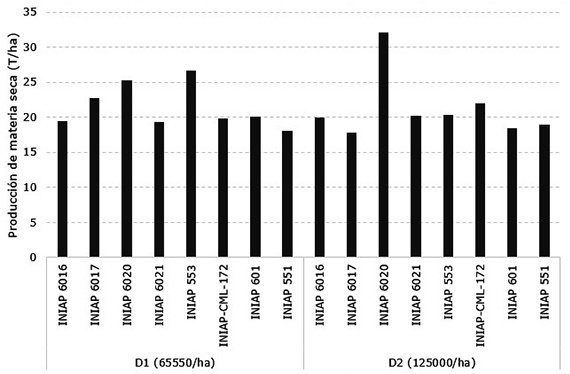
Figure 3. Density interaction for planting INIAP hybrids in relation to production of
dry material, Pichilingue Station 2013.
Plant height. This variable presented significance (p<0.05) for planting densities according to plant height. Similarly, a high statistical variation (p<0.01) was established for INIAP hybrids. By comparing measurements, two ranges of significance were determined (Table 2). In the first range INIAP 6017, INIAP 6016 were placed, and in the following one INIAP 551; INIAP H 601; INIAP H 553; INIAP CML-172; INIAP 6021 and INIAP 6020 (Table 2). The variation coefficients for large lots was 1.50%, subplots 7.14% and sub-subplots 10.13% are appropriate for field studies.
Crude protein. A statistical significance was found (p<0.05), for PC content, which is influenced by the planting season. After doing the Tukey test, it was divided in two mean ranges of classification, in the first the January 28 2013 planting season was found with an average of 10.45% and the second April 8 with an average of 9.87%. For INIAP maize hybrids a major statistical difference was found in the percentage of PC (p<0.0001). Four mean ranges were detected according to Tukey, in the first one INIAP CML-172 and INIAP 6021 hybrids was found, in the second one INIAP 551, INIAP H 553 and INIAP 6016, in the third INIAP 6020, and in the fourth INIAP H 601 and INIAP 6017 (Table 2). The variation coefficients for large plots at 5.58%, subplots at 6.42% and sub-subplots at 4.70% support the findings in this study.
DISCUSSION
Influence on fresh matter. A direct relationship between water supply at the time of planting and the production of fresh maize was established. That is, a larger supply of water increased the production of fresh maize. These results are consistent with those reported by Ramirez et al (12) and Montemayor et al (13) who reported that the production of fresh maize increased 2.5 times when they went from using gravitational irrigation to a more intense drip irrigation.
Fresh matter production was significantly affected proportional to planting. Increasing planting density (from 40.000 to 100.000 plants / ha) is a method employed to increase production of biomass due to increased internal processes, leaf area indexes, light interception, and growth range (14). Regarding total production of fresh material, Yilmaz et al (6), concluded that fodder production differs statistically with planting densities and consistently increases from 114.000 plants/ha, and decreases from 143.000 plant/ha.
The hybrids with greater average production of fresh material were INIAP 551 (61.58 Tons/ha), INIAP H 601 (60.92 Tons/ha), INIAP H 553 (60.42 Tons/ha) and INIAP CML-172 (60.17 Tons/ha). These data can be compared with those obtained in Colombia in the Middle Sinú Valley by Cabrales et al (15), who evaluated 25 fodder maize genotypes and the best ones were Vera-225 (61.13 Tons/ha), SNPL-111 (60.62 Tons/ha) and ICA-V-156 (60.42 Tons/ha). According to Núñez et al (16) in a study conducted in Mexico with hybrid maize, fodder producers established a density of 80 thousand plants/ha with irrigation and three phases of maturity, with an average of 57.90 Tons/ha of green fodder, and from there we can see that the productivity of hybrid INIAP maize is acceptable.
Influence on dry matter. The planting density at 125.000 plants / a used in this study expresses a higher yield production for this parameter. Hence, the use of high densities of corn is a way of optimizing the soil use (17). Turgut et al (18), Yilmaz et al (6), and Budakli-Carpici (19) reported that different densities to maximize dry matter production range from 70.000 to 165.000 plants / ha. This trend was observed in this study.
In this investigation, INIAP 6020 hybrid (28.25 Tons/ha), followed by INIAP 553 (23.17 Tons/ha) and INIAP CML-172 (20.42 Tons/ha) were the highest producing materials in dry matter. These data can be confronted with those of Cabrales et al (15) who evaluated 25 fodder maize genotypes in the Turipaná Investigation Center in Corpoica, Córdoba, where the HIT 34 genotype had a total of 22.00 Tons/ha, Vera 225 recorded 20.11 Tons/ha and SNLP 111 produced 19.20 Tons/ha. Lower humidity content is associated with more mature plants.
The interaction that showed the greatest production of dry matter was the planting density of 125.000 plants/ha by the INIAP 6020 hybrid (32.08 t/ha). That is, there was a direct proportional relationship between planting density and dry matter production. These results are similar to those found by Budakli-Carpici et al (19). In that study in the April 8 planting season, the plants had a water deficit in June and July (Figure 1), which did not create the best conditions to support a higher planting density (Figure 3).
Influence on plant height. A directly proportionally significant effect between plant height and plant density was found. This trend was confirmed by Gözübenli (20) who showed that plant height increases as a result of plant density and the larger maize plants were measured and showed 2.08 m at a planting density of 120.000 plants/ha and the lowest was 1.99 m at a density of 80.000 plants/ha. Increased maize planting density results in a narrower and longer stem. Studies have revealed that thin stem diameters and large plants were observed at high plant densities (17).
In this investigation the hybrids that reached greater height were INIAP 6017 (2.60 m) and INIAP 6016 (2.47 m), while the rest of the materials were homogenous: INIAP 6021 (2.45 m); INIAP 553 (2.44 m); INIAP CML-172 (2.44 m); INIAP H 601 (2.41 m); INIAP 551 (2.40 m) and INIAP 6020 (2.39 m). Acosta (21) highlighted that an average tropical creole maize plant reaches a height of 2.20 to 3.20 m. Data obtained in this study could be compared to a study done by Sánchez et al (22) who studied the response to the selection of tropical varieties of maize in Mexico and reported an average plant height of 2.13 to 2.22 m. On the other hand, Ramírez et al (12) reported in their evaluation on the behavior of fodder maize under different irrigations in Torreón-San Pedro, Coahuila, Mexico, where gravitational irrigation recorded a height of 2.15 m and a greater density by drip irrigation was reached, 2.97 m.
Influence on Crude Protein content (PC). Statistical significances for planting seasons (p<0.05) were found; the Tukey test (5%) was performed, and the January 28, 2013 planting season came in first for PC content to (10.48%), followed by the April 8 2013 planting season (9.87%). These results are consistent with those obtained by Marsalis et al (4) and Gallegos et al (23), who argue that the CP content of maize genotypes is affected by low amounts of irrigation water.
Cusicanqui and Lauer (24) found a decrease in the PC content with an increase in planting density of 44,500 to 104,500 plants/ha. These results are supported by studies conducted by Cox and Cherney (25), who reported a reduction of PC in high planting densities of maize (116.000 plants/ha vs. 80,000 plants/ha). This tendency was not observed in this study (p˃0.05).
Statistical differences between the INIAP material investigated (p<0.001) in the PC content. The general average for INIAP hybrids was 10.62% (±1.12). Upon performing the Tukey test at 5%, four ranges were established; in the first range INIAP H 553 (11.67%) and INIAP 6021 (11.42%). INIAP H 601 (10.50%) and INIAP 6016 (10.08%) Were in the second range and in the third was INIAP 6020 (9.50%). In the Municipality of Gómez Palacios, Durango, México, the PC content shown by the fodder maize genotypes San Lorenzo 9.04%, AS-905 9.01% and RS-9022 8.57% (23) were below the PC content for INIAP hybrids. According to the standards of Peña et al (26), ranges of PC percentages from 8–12 are considered low quality levels.
In conclusion, the maize crop in the Pichilingue Tropical Experimental Extension of the INIAP›s area of influence is seasonally dependent exclusively on rainfall. Results obtained in this study indicate that the time of maximum rainfall (planting date January 28) had 11.38% greater production of green matter than maize planted at the time of reduced rainfall (April 8 planting date). A reduced seeding density of 125,000 to 65,500 plants/ha reduced the production of green matter by 10.30%. Regarding maize hybrid density interaction, the INIAP 6020 hybrid and 125,000 seeding density was 20.11% greater than the INIAP 551 interaction density by planting 65,500 plants/ha in relation to production of dry material.
The behavior of eight hybrids evaluated in these four variables were diverse. Thus, INIAP CML 172 hybrids with a MF production of 60.17 Tons/ha; MS 20.42 Tons/ha; AP 2.44 m and PC 11.66%. The INIAP 6021 hybrid with a MF production of 59.16 Tons/ha; MS 19.33 Tons/ha; AP 2.45 m and PC 10.42%. INIAP 551 hybrid with a MF production of 61.58 Tons/ha; MS 18.92 Tons/ha; AP 2.40 m and PC 11.66%. The performance of these three INIAP maize hybrids shows they are very acceptable in relation to the variables evaluated and can be spatially used for silage.
It is recommended that an evaluation of planting times and nutritional characteristics of these eight hybrids INIAP be done regarding the content of neutral detergent fiber, acidic detergent fiber, in vitro digestibility and ethereal extract. Additionally, an economic analysis between maize productions as opposed to fodder production in order to determine its economic viability.
REFERENCES
1. Cornejo C, Wilkie A. Greenhouse gas emissions and biogas potential from livestock in Ecuador. Energy Sustain Dev 2010; 14(4):256-266.
2. Mannetje L, Ramírez L, Ibrahin M, Sandoval C, Ojeda N, Ku J. Third International Symposium on Silvopastoral Systems. Mérida, Yucatan, México: IUFRO; 2004.
3. Zamora S, Ruiz F, Beltrán F, Fenech L, Murillo B, Loya J, Troyo E. Régimen hídrico del maíz en una zona áridad, determinando en porcentajes de evaporación. Trop Subtrop Agroecsyt 2011; 13(2):181-186.
4. Marsalis MA, Angadi SV, Contreras, FE. Dry matter yield and nutritive value of corn, forage sorghum, and BMR forage sorghum at different plant populations and nitrogen rates. Field Crops Res 2010; 116(1):52-57.
5. Iptas S, Acar, A.A. Effects of hybrid and row spacing on maize forage yield and quality. Plant Soil Environ 2006; 52(11):515-522.
6. Yilmaz S, Erayman H, Gozubenli H, Can E. Twin or Narrow Row Planting Patterns versus Conventional Planting in Forage Maize Production in the Eastern Mediterranean. Cereal Res Commun 2008; 36(5):189-199.
7. Sarlangue T, Fernado H, Calvino P, Purcell L. Why do maize hybrids responde differently to cariations in plant density. Agron J 2007; 99(4):984-991.
8. Cañadas A, Rade D, Zambrano C, Molina C, Arce L. Evaluación y manejo de fuentes semilleras de Teca en la Estación Experimental Tropical Pichilingue-Ecuador. Avances USFQ 2013; 5(1):64-75.
9. Cañadas L. El mapa bioclimático y ecológico del Ecuador. Quito: Editores Asociados; 1983.
10. SAS Institute INC. 2010. SAS/STATTM. Release 8.0 Ed. Cary. NC. USA.
11. Association of Analytical Communities. Official Methods of the AOAC International. Gaithersbur, MD: AOAC; 2012.
12. Ramírez JO, Montenegro JA, Bravo SR, Hernández MF, Aldaco RA, Ruiz E. Características agronómicas y calidad de maíz forrajero con riego sub-superficial. Téc Pecu Méx 2006; 44(3):351-357.
13. Montenegro A, Lara L, Woo L, Munguía J, Rivera M, Trucíos R. Sistema de irrigación en la comarca de Lagunera de Coahuila y Durando, México. Agrociencia 2012; 46(3):267-278.
14. Baron VS, Najda HG, Stevenson, FC. Influence of population density, row spacing and hybrid of forage corn yield and nutritive value in a cool-season environment. Can J Plant Sci 2006; 86(4):1131-1138.
15. Cabrales R, Montoya R, Rivera J. Evaluación agronómica de 25 genotipos de maíz (Zea maiz) con fines forrajeros en el valle de Sinú Medio. Rev MVZ Córdoba 2007; 12(2):1054-1060.
16. Núñez HG, Faz RC, Gonzáles CF, Peña AR. Madurez de híbridos de maíz a la cosecha para mejorar la producción y calidad del forraje. Téc Pecu Méx 2005; 43(1):69-78.
17. Subedi KD, Smith BL, Smith DL. Response of a leafy and non-leafy maize hybrid to population densities and fertilizer nitrogen levels. Crop Sci 2006; 46(5):1860-1869.
18. Turgut I, Duman A, Bilgili U, Acikgoz E. Alternate Row Spacing and Plant Density Effects on Forage and Dry Matter Yield of Cron Hybrids (Zea maiz L.). J Agron Crop Sci 2005; 191(2):146-151.
19. Buldakli-Çarpici E, Çelik N, Bayran G. Yield and Quality of Forage maize as influenced by Plant Density and Nitrogen Rate. Turk J Fiedl Crops 2010; 15(2):128-132.
20. Gözübenli H. Influence of Planting Patterns and Plant Density on the Performance of Maize Hybrids in the Eastern Mediterranean Conditions. Inter J Agric Biology 2012; 12(4):556-560.
21. Acosta R. El cultivo del maíz, su origen y clasificación. El maíz de Cuba. Cultivos Tropicales 2009; 30(2):113-120.
22. Sanchez MA, Aguilar CU, Valenzuela N, Sánchez C, Jiménez MC, Villanueva Clemente. Densidad de siembra y crecimiento de maíces forrajeros. Agronomía Mesoamericana. 2011; 22(2):281-295.
23. Gallegos A, Martínez A, Sánchez M, Figueroa R, Berumen S, Vengegas J, Quevedo J, Escobedo D, Silos M. Calidad nutricional del maíz forrajero (Zea mays L.) bajo condiciones limitadas de agua de riego. Agrofaz. 2012; 12(1):59-66.
24. Cusicanqui J, Lauer J. Plant Density and Hybrid Influence on Corn Forage Yield and Quality. Agron J. 1999; 91:911-915.
24. Cox WJ, Cherney DJR. Row spacing, plant density and nitrogen effects on corn silage. Agron J. 2001; 93(3):597-602.
26. Peña A, Gonzáles F, Robles F. Manejo agronómico para incrementar el rendimiento de grano y forraje híbridos tardíos de maíz. REMEXCA 2010; 1(1):27-35.